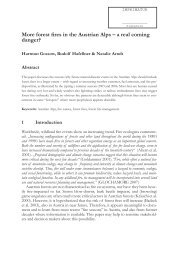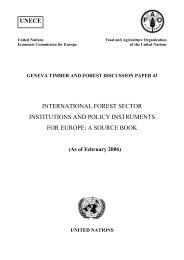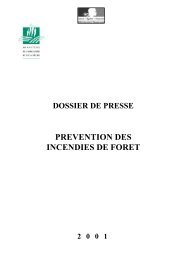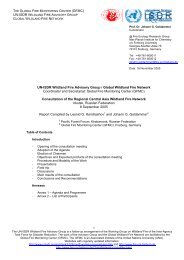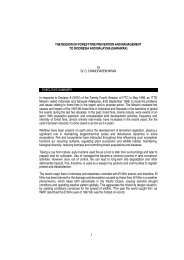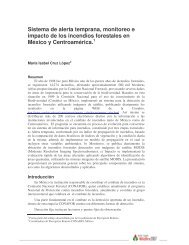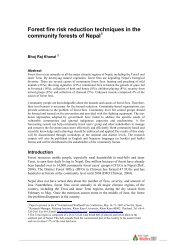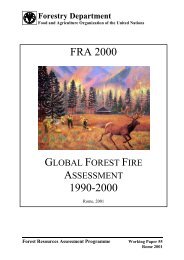Communities in flames - The Global Fire Monitoring Center (GFMC)
Communities in flames - The Global Fire Monitoring Center (GFMC)
Communities in flames - The Global Fire Monitoring Center (GFMC)
You also want an ePaper? Increase the reach of your titles
YUMPU automatically turns print PDFs into web optimized ePapers that Google loves.
<strong>Communities</strong> <strong>in</strong> <strong>flames</strong>:<br />
proceed<strong>in</strong>gs of an <strong>in</strong>ternational conference<br />
on community <strong>in</strong>volvement <strong>in</strong> fire<br />
management<br />
Edited by<br />
RAP PUBLICATION 2002/25<br />
Peter Moore, David Ganz, Lay Cheng Tan, Thomas Enters<br />
and Patrick B. Durst<br />
Food and Agriculture Organization of the United Nations<br />
Regional Office for Asia and the Pacific<br />
Bangkok, Thailand<br />
2002
<strong>The</strong> designations employed and the presentation of material <strong>in</strong> this publication<br />
do not imply the expression of any op<strong>in</strong>ion whatsoever on the part of the Food<br />
and Agriculture Organization of the United Nations concern<strong>in</strong>g the legal status<br />
of any country, territory, city or area or of its authorities, or concern<strong>in</strong>g the<br />
delimitation of its frontiers or boundaries.<br />
Staff and consultants of Project <strong>Fire</strong>Fight South East Asia prepared this<br />
publication. <strong>The</strong> analyses and assessments conta<strong>in</strong>ed here<strong>in</strong> do not necessarily<br />
reflect the views of Project <strong>Fire</strong>Fight South East Asia, the Worldwide Fund for<br />
Nature (WWF) and <strong>The</strong> World Conservation Union (IUCN).<br />
All rights reserved. No part of this publication may be reproduced, stored <strong>in</strong> a<br />
retrieval system, or transmitted <strong>in</strong> any form or by any means, electronic,<br />
mechanical, photocopy<strong>in</strong>g or otherwise, without the permission of the copyright<br />
owner. Applications for such permission, with a statement of the purpose and<br />
extent of the reproduction, should be addressed to the Senior Forestry Officer,<br />
Food and Agriculture Organization of the United Nations, Regional Office for<br />
Asia and the Pacific, 39 Phra Atit Road, Bangkok, Thailand.<br />
Cover photos:<br />
Background picture:<br />
Eucalyptus plantation <strong>in</strong> Congo by Takeshi Toma, CIFOR, Indonesia<br />
Four small pictures from left to right:<br />
Efforts to ext<strong>in</strong>guish fires <strong>in</strong> East Kalimantan, Indonesia, <strong>in</strong> 1998 © WWF-Cannon/WWF<br />
Indonesia<br />
Forest fires <strong>in</strong> K<strong>in</strong>abaangan <strong>in</strong> Sabah, Malaysia, <strong>in</strong> 1998 © WWF-Cannon/WWF Malaysia<br />
Haze from fires <strong>in</strong> Kuala Lumpur, Malaysia, <strong>in</strong> 1998 © WWF-Cannon/WWF Malaysia<br />
Forest fire <strong>in</strong> Costa Rica by Stephen Homer, ACDI-CIDA<br />
Large picture:<br />
Sungai Manau Jambi, Ker<strong>in</strong>ci National Park, Indonesia, by Ala<strong>in</strong> Compost<br />
For copies of the proceed<strong>in</strong>gs, write to:<br />
Patrick B. Durst<br />
Senior Forestry Officer<br />
FAO Regional Office for Asia and the Pacific<br />
39 Phra Atit Road<br />
Bangkok 10200<br />
Thailand<br />
Tel: (66-2) 697 4000<br />
Fax: (66-2) 697 4445<br />
Email: Patrick.Durst@fao.org<br />
© FAO & <strong>Fire</strong>Fight South East Asia 2002<br />
ISBN 974-7946-29-7
Foreword<br />
Decentralisation and devolution are dom<strong>in</strong>ant concepts <strong>in</strong> contemporary discussions on natural<br />
resource policy and management throughout the world. In forestry, decentralised governance and<br />
grant<strong>in</strong>g greater decision-mak<strong>in</strong>g authority to local people has a long history. Recently, <strong>in</strong>novative<br />
and progressive policies and legislation have strengthened and formalised what <strong>in</strong> many locations<br />
were previously <strong>in</strong>formal <strong>in</strong>stitutional arrangements for manag<strong>in</strong>g local forests.<br />
<strong>The</strong>re are several factors driv<strong>in</strong>g these trends toward <strong>in</strong>creased participation of local<br />
stakeholders <strong>in</strong> forestry. In some cases, greater decentralisation and devolution is aris<strong>in</strong>g from a<br />
realization that central governments often lack the capacity to manage forests effectively. In many<br />
places, governments are themselves advocates of <strong>in</strong>creased partnership with local people,<br />
recognis<strong>in</strong>g that their own forest management resources are <strong>in</strong>adequate. In other areas, local<br />
stakeholders are simply assert<strong>in</strong>g their roles more aggressively than <strong>in</strong> the past. In nearly all<br />
<strong>in</strong>stances, when local people are given a mean<strong>in</strong>gful stake <strong>in</strong> forest management decision-mak<strong>in</strong>g,<br />
there is a demonstrated improvement <strong>in</strong> the way forest resources are managed.<br />
As global concern over the fate of the world’s forests has grown generally, so too has specific<br />
concern over the frequency and <strong>in</strong>tensity of forest fires, which have <strong>in</strong>creased dramatically as a<br />
result of human activities <strong>in</strong> recent years. <strong>The</strong> major forest fires of 1997 and 1998 <strong>in</strong> Asia and<br />
elsewhere around the globe <strong>in</strong>flicted enormous ecological damage and human suffer<strong>in</strong>g. A positive<br />
result, however, has been an awaken<strong>in</strong>g of world attention to the challenges of fire management <strong>in</strong><br />
the modern era. To some, the massive fires of the 1990s were viewed not just as a local emergency,<br />
but rather as a human-<strong>in</strong>duced planetary disaster that should never to be allowed to occur aga<strong>in</strong>.<br />
S<strong>in</strong>ce the widespread fires of the late 1990s, numerous agencies and organizations have<br />
supported various fire prevention, suppression and management <strong>in</strong>itiatives. <strong>The</strong>se efforts have<br />
<strong>in</strong>dicated that no s<strong>in</strong>gle actor, whether government or civil society, can <strong>in</strong>dependently solve the<br />
serious social, economic and ecological challenges associated with uncontrolled forest fires.<br />
Importantly, it is now <strong>in</strong>creas<strong>in</strong>gly recognized that, <strong>in</strong> many countries, local communities can play<br />
significant positive roles <strong>in</strong> fire management, particularly when work<strong>in</strong>g <strong>in</strong> close collaboration<br />
with formal forest and fire management authorities.<br />
In develop<strong>in</strong>g appropriate community-based forest fire management systems, much can be<br />
learned from the lessons ga<strong>in</strong>ed <strong>in</strong> decentralis<strong>in</strong>g and devolv<strong>in</strong>g forest management. Nevertheless,<br />
important differences between manag<strong>in</strong>g fires and manag<strong>in</strong>g forests exist, and care must be taken <strong>in</strong><br />
adopt<strong>in</strong>g <strong>in</strong>stitutional arrangements, approaches, tools and methods designed for different purposes.<br />
Information on <strong>in</strong>volv<strong>in</strong>g communities <strong>in</strong> fire management is still scarce, widely scattered<br />
and only slowly emerg<strong>in</strong>g. <strong>The</strong> <strong>Communities</strong> <strong>in</strong> <strong>flames</strong> proceed<strong>in</strong>gs provides long-awaited and<br />
first-hand <strong>in</strong>sights <strong>in</strong>to community-based forest fire management. <strong>The</strong> strength of the publication<br />
lies <strong>in</strong> the diversity of the contributions and the recognition that the role that communities can<br />
play is not overstated. Other stakeholders, <strong>in</strong>clud<strong>in</strong>g the government and the private sector, must<br />
also play a substantial role <strong>in</strong> forest fire management.<br />
We hope that this publication will prove useful to those responsible for formulat<strong>in</strong>g and<br />
implement<strong>in</strong>g fire management policies and programs <strong>in</strong> better understand<strong>in</strong>g the key issues and<br />
challenges of <strong>in</strong>volv<strong>in</strong>g local people as effective partners <strong>in</strong> manag<strong>in</strong>g forest fires.<br />
He Changchui<br />
FAO Regional Representative<br />
for Asia and the Pacific<br />
Bangkok, Thailand<br />
iii
Preface<br />
Large-scale fires throughout the world <strong>in</strong> recent times have demonstrated the social, economic<br />
and ecological costs of uncontrolled fires and have received unprecedented coverage <strong>in</strong> the<br />
<strong>in</strong>ternational media. To combat the negative impacts, national and <strong>in</strong>ternational agencies have<br />
called for improvement <strong>in</strong> controll<strong>in</strong>g forest fires.<br />
Unfortunately, government responses to forest fires have tended to focus on suppression and<br />
costly technological solutions to fight fires. Contrary to alleviat<strong>in</strong>g forest fire problems, they have<br />
often <strong>in</strong>creased the scale and magnitude of forest fires, and ignored the positive dimensions of fire<br />
<strong>in</strong>clud<strong>in</strong>g the social and ecological benefits of smaller, prescribed burns. <strong>The</strong>se conventional<br />
measures are <strong>in</strong>creas<strong>in</strong>gly be<strong>in</strong>g questioned as the number of forest fires <strong>in</strong>creases.<br />
In addition, decreas<strong>in</strong>g governmental budgets to susta<strong>in</strong> suppression management regimes have<br />
led many agencies to explore more proactive approaches <strong>in</strong> combat<strong>in</strong>g fires before they occur. Over<br />
the last decade, there have been calls to revisit traditional forest fire management regimes, which<br />
emphasise prescribed burn<strong>in</strong>g and prevention. <strong>The</strong>se have been seen as more effective <strong>in</strong> temper<strong>in</strong>g<br />
unwanted fires, more beneficial to local ecosystems and less costly <strong>in</strong> the long term.<br />
In December 2000, Project <strong>Fire</strong>Fight South East Asia and the Regional Community Forestry<br />
Tra<strong>in</strong><strong>in</strong>g <strong>Center</strong> (RECOFTC) organized a regional workshop on community-based fire<br />
management (CBFiM). <strong>The</strong> workshop concluded that successful CBFiM strategies and<br />
experiences should be shared with government agencies to combat the persistent paradigm that<br />
suppression and enforcement are the only effective ways to manage fires.<br />
<strong>The</strong> <strong>Communities</strong> <strong>in</strong> <strong>flames</strong> conference was organized to serve that purpose. <strong>The</strong> objectives<br />
of conference were to:<br />
♦ expose forestry departments/fire control agencies to alternative approaches to forest fire<br />
management, which promote the participation of local communities <strong>in</strong> plann<strong>in</strong>g, and<br />
manag<strong>in</strong>g their own forest fires regimes (with<strong>in</strong> the context of past/traditional practices<br />
and their socio-economic needs of local communities);<br />
♦ exam<strong>in</strong>e the approaches and elements for promot<strong>in</strong>g these alternatives to civil society<br />
(<strong>in</strong>clud<strong>in</strong>g identify<strong>in</strong>g fire research needs, forest policy amendments, legal and<br />
regulatory structures and appropriate strategies for socialis<strong>in</strong>g CBFiM); and<br />
♦ collect examples of the approaches taken by communities worldwide to manage and use<br />
their fires as a resource, and to further clarify and analyse the potential to capture the<br />
opportunities which these alternatives have to offer.<br />
<strong>The</strong>se objectives were pursued through the presentation and discussion of high-quality case<br />
studies and analytical papers from around the world. <strong>The</strong> conference was targeted to present a<br />
synthesis of lessons learned from CBFiM and its benefits <strong>in</strong> mitigat<strong>in</strong>g fires. Among the 120<br />
participants were <strong>in</strong>dividuals and representatives of organizations that have extensive knowledge<br />
and experience of CBFiM, <strong>in</strong>clud<strong>in</strong>g a strong local non-governmental organizational presence.<br />
Representatives from forestry departments and other governmental agencies <strong>in</strong>volved with landuse<br />
plann<strong>in</strong>g, disaster management and fire control also participated <strong>in</strong> large numbers. Academics<br />
and researchers, directly or <strong>in</strong>directly <strong>in</strong>volved <strong>in</strong> fire management-related issues such as land-use<br />
plann<strong>in</strong>g, shift<strong>in</strong>g cultivation and air quality, were also active participants.<br />
iv
Acknowledgements<br />
Project <strong>Fire</strong>Fight South East Asia, a global <strong>in</strong>itiative of the World Conservation Union (IUCN)<br />
and the World Wide Fund for Nature (WWF), was the lead organizer of the <strong>Communities</strong> <strong>in</strong><br />
<strong>flames</strong> <strong>in</strong>ternational conference. In all aspects of plann<strong>in</strong>g, organiz<strong>in</strong>g and conduct<strong>in</strong>g the<br />
conference, the Project worked closely with the Regional Community Forestry Tra<strong>in</strong><strong>in</strong>g <strong>Center</strong><br />
(RECOFTC) and the Food and Agriculture Organization of the United Nations (FAO). Essential<br />
support for plann<strong>in</strong>g and undertak<strong>in</strong>g the conference and field trips came from local communities<br />
and non-governmental organizations <strong>in</strong> collaboration with the German Agency for Technical Cooperation<br />
(GTZ)’s Integrated Forest <strong>Fire</strong> Management Project, the Prov<strong>in</strong>cial Government of East<br />
Kalimantan and the District Government of Balikpapan, which hosted the event. <strong>The</strong> M<strong>in</strong>istry of<br />
Forestry of the Government of Indonesia, the FAO, the European Union and the United States<br />
Department of Agriculture Forest Service provided f<strong>in</strong>ancial resources and other support.<br />
<strong>The</strong> efforts of the many <strong>in</strong>dividuals were co-ord<strong>in</strong>ated and channelled by three committees,<br />
whose contributions were essential to the conference’s suc cess and are gratefully acknowledged:<br />
Steer<strong>in</strong>g Committee:<br />
♦ Wahjudi Wardojo M<strong>in</strong>istry of Forestry, Indonesia<br />
♦ Peter Moore Project <strong>Fire</strong>Fight South East Asia<br />
♦ David Ganz FAO/RECOFTC, Bangkok, Thailand<br />
National Organiz<strong>in</strong>g Committee:<br />
♦ Dicky Simorangkir Project <strong>Fire</strong>Fight South East Asia<br />
♦ Benni Sorm<strong>in</strong> FAO, Jakarta, Indonesia<br />
♦ Hartmut Abberger GTZ Integrated Forest <strong>Fire</strong> Management Project<br />
♦ Soedarmo and Sumantri M<strong>in</strong>istry of Forestry, Indonesia<br />
Local Organiz<strong>in</strong>g Committee:<br />
♦ Prov<strong>in</strong>cial Government of East Kalimantan, Indonesia<br />
♦ District Government of Balikpapan, Indonesia<br />
♦ GTZ Integrated Forest <strong>Fire</strong> Management Project<br />
Editorial Committee:<br />
♦ Bob Fisher RECOFTC, Bangkok, Thailand<br />
♦ Cecilia Danks Watershed Research and Tra<strong>in</strong><strong>in</strong>g <strong>Center</strong>, Hayfork,<br />
California, United States<br />
♦ Greg Hill Department of Science, Information Technology and<br />
Education, University of the Northern Territory,<br />
Darw<strong>in</strong>, Australia<br />
♦ Thomas Enters FAO, Bangkok, Thailand<br />
♦ Willistra Danny <strong>Fire</strong> Control Directorate, M<strong>in</strong>istry of Forestry,<br />
Indonesia<br />
♦ Yvonne Everett Department of Natural Resources Plann<strong>in</strong>g and<br />
Interpretation, Humboldt State University, Arcata,<br />
California, United States<br />
v
vi<br />
Abbreviations<br />
BMG Badan Meteorologi dan Geofisika<br />
BPS Badan Pusat Statistik<br />
CBFFM Community-based Forest <strong>Fire</strong> Management<br />
CBFiM Community-based <strong>Fire</strong> Management<br />
CIFOR <strong>Center</strong> for International Forestry Research<br />
CVA Capacity and Vulnerability Analysis<br />
DEPHUT Departemen Kehutanan<br />
DoF Directorate of Forestry (Namibia)<br />
ENSO El Niño Southern Oscillation<br />
FFPMP Forest <strong>Fire</strong> Prevention Management Project<br />
FMUs <strong>Fire</strong> Management Units<br />
FPAs <strong>Fire</strong> Protection Associations<br />
FAO Food and Agriculture Organization of the United Nations<br />
FSC Forest Safe Council<br />
GEF <strong>Global</strong> Environment Facility<br />
<strong>GFMC</strong> <strong>Global</strong> <strong>Fire</strong> Monitor<strong>in</strong>g <strong>Center</strong><br />
GGFP Gambian-German Forestry Project<br />
GIS Geographic Information System<br />
GPS Geographic Position<strong>in</strong>g System<br />
GTZ German Agency for Technical Co-operation<br />
HLS Household livelihood security<br />
HPH Hak Penguasaan Hutan<br />
HTI Hutan Tanaman Industri<br />
ICRAF International Centre for Research <strong>in</strong> Agroforestry<br />
IFM Integrated <strong>Fire</strong> Management<br />
IFFM Integrated Forest <strong>Fire</strong> Management<br />
IGB Integrated green belt<br />
ITCs Information and Tra<strong>in</strong><strong>in</strong>g Centres<br />
IUCN <strong>The</strong> World Conservation Union<br />
JFM Jo<strong>in</strong>t Forest Management<br />
Kanitab Kader Tani Menetap<br />
KBDI Keetch Byram Drought Index<br />
KWNP Kiang West National Park<br />
MPTS Multipurpose tree species<br />
NFFP Namibia-F<strong>in</strong>land Forestry Program<br />
NFTs Nitrogen-fix<strong>in</strong>g tree species<br />
NGOs Non-governmental organizations<br />
NOAA National Oceanic Atmosphere Adm<strong>in</strong>istration<br />
NTFPs Non-timber forest products<br />
PCA Participatory Communication Approaches<br />
PLA Participatory Learn<strong>in</strong>g and Action<br />
PMDH Pembangunan Masyarakat Desa Hutan
PULK Pertanian Usaha Lahan Ker<strong>in</strong>g<br />
R Rand<br />
RECOFTC Regional Community Forestry Tra<strong>in</strong><strong>in</strong>g <strong>Center</strong><br />
RFD Royal Forest Department (Thailand)<br />
RMT Rangeland Management Team<br />
Rp Rupiah<br />
RT Rukun tetangga<br />
SA South Africa<br />
SALT Slop<strong>in</strong>g Agricultural Land Technology<br />
SOPs Standard Operat<strong>in</strong>g Procedures<br />
TAC Technical Advisory Committee<br />
UNESCO United Nations Educational, Scientific, and Cultural Organization<br />
USFS United States Department of Agriculture Forest Service<br />
VFDs Volunteer <strong>Fire</strong> Departments<br />
VFFPC Village Forest <strong>Fire</strong> Prevention Committee<br />
WWF World Wide Fund for Nature<br />
vii
viii<br />
Table of contents<br />
Foreword iii<br />
Preface v<br />
Acknowledgements vi<br />
Abbreviations vii<br />
Liv<strong>in</strong>g with fire: summary of <strong>Communities</strong> <strong>in</strong> <strong>flames</strong> <strong>in</strong>ternational conference<br />
David Ganz and Peter Moore 1<br />
Community <strong>in</strong>volvement <strong>in</strong> fire management: cases and recommendations for community-based<br />
fire management <strong>in</strong> Thailand<br />
Pearmsak Makarabhirom, David Ganz and Sur<strong>in</strong> Onprom 10<br />
Learn<strong>in</strong>g across borders: community-based fire management - Kalimantan to California<br />
Judith Mayer 16<br />
Community-based fire management, land tenure and conflict:<br />
<strong>in</strong>sights from Sumatra, Indonesia<br />
S. Suyanto, Grahame Applegate and Luca Tacconi 27<br />
Community participation <strong>in</strong> <strong>in</strong>tegrated forest fire management:<br />
experiences from Africa, Asia and Europe<br />
Johann G. Goldammer, Peter G.H. Frost, Mike Jurvélius, Evelien M. Kamm<strong>in</strong>ga,<br />
Teri Kruger, Soo Ing Moody and Manuel Pogeyed 33<br />
<strong>The</strong> development of a community-based approach for an <strong>in</strong>tegrated<br />
forest fire management system <strong>in</strong> East Kalimantan, Indonesia<br />
Hartmut M. Abberger, Bradford M. Sanders and Helmut Dotzauer 53<br />
Experiences <strong>in</strong> community forest fire control <strong>in</strong> Viet Nam<br />
Ha Thi L<strong>in</strong>h 66<br />
Forest and fire suppression <strong>in</strong> East Kalimantan, Indonesia<br />
Chandradewana Boer 69<br />
Ext<strong>in</strong>guish<strong>in</strong>g the 1998 forest fires and subsequent coal fires <strong>in</strong> the<br />
Sungai Wa<strong>in</strong> Protection Forest, East Kalimantan, Indonesia<br />
Gabriella Fredriksson 74<br />
Community-based disaster management as a response to <strong>in</strong>creased risks to<br />
disaster with emphasis on forest fires<br />
Johan Kieft and Aspian Nur 81
Review of the participatory forest fire prevention programmes<br />
<strong>in</strong> Jambi and West Kalimantan, Indonesia<br />
Masahiro Otsuka, Sumantri, Kuspriyadi and Syaharudd<strong>in</strong> 90<br />
Why don’t they come and discuss together? Community-<strong>in</strong>itiated<br />
stakeholder co-ord<strong>in</strong>ation on forest fire management <strong>in</strong> rural Gambia<br />
Kebba Sonko, Saikou Samateh, Kanimang Camara and Clemens Beck 101<br />
Forest fire <strong>in</strong> the context of territorial rights <strong>in</strong> northern Thailand<br />
Atchara Rakyutidharm 112<br />
<strong>Fire</strong> <strong>in</strong> miombo woodlands: a case study of Bukombe District Sh<strong>in</strong>yanga, Tanzania<br />
Nssoko Edw<strong>in</strong> 117<br />
Traditional community-based fire management among the Mizo shift<strong>in</strong>g cultivators<br />
of Mizoram <strong>in</strong> northeast India<br />
V.T. Darlong 119<br />
Community participation <strong>in</strong> fire management plann<strong>in</strong>g: a case from California, USA<br />
Yvonne Everett 125<br />
ix





